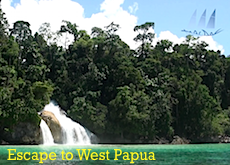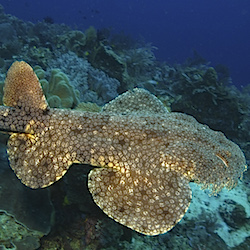Sailing & Scuba diving in Indonesia, aboard the luxury liveaboard
Sailing & Scuba diving in Indonesia, aboard the luxury liveaboard
*please check our "Agenda" for your date.
Cruises are scheduled at the ideal times of the year and conditions should generally be calm. Except while crossing or in the open sea. The waters around the open sea sites are very deep and the sites may be exposed to the weather.
Tropical climate. Refreshing breezes onboard throughout most of the season.
This may not be the cruise destination for every diver, more for adventure divers but not for novices. The visibility can be very low, as low as 5-10m. Unexpected sightings can happen though maybe not happen on every trip. In this area every trip is very different. CURRENTS can be varied, depending on the moon phase. Especially in the Banda Sea
Avg. 27° to 30°C
The WAOW staff will pick you up in your hotel or await your arrival at Kaimana or Saumlaki airport to assist and accompany you on board SMY WAOW, only a short drive of around 15-30 mins away. Our experienced staff will look after your luggage and transfer it to your cabin onboard SMY WAOW while you enjoy our "refreshing welcome drink". As soon as the last guests are onboard around 2:00PM, you will be introduced to our team and have plenty of time to settle in, get everything ready and enjoy life onboard with us.
Early breakfast before disembarkation & transfer to the airport or hotel between 06.00AM and 11.00AM at the latest

Cruise Info in process of translation.
TEMPS FORTS DE LA CROISIERE
Cet itinéraire est parfait pour ceux qui souhaitent plonger hors des sentiers battus, tout en combinant différentes variété de plongées et de paysages : poissons pélagiques, macro-faune rare, plongées d’exploration rares puis ballades entre jungle épaisse et plages paradisiaques. Depuis Jamdena (la plus grande de l’archipel de Tanimbar), vous naviguerez à l’Est de la Mer de Banda en suivant le tracé du «Cercle de Feu» qui borde la plus grande faille de l’archipel, profonde de 7km. Après un stop aux îles Kai, vous prendrez la direction de Kurkap puis enfin celle de Mommon puis Kaïmana pour explorer la célèbre baie de Triton, en Papouasie Occidentale. Cette croisière est opérée en Saumlaki - Kaïmana ou vice-versa et la durée des étapes sera conditionnée par les conditions de navigation en haute mer.
A Jamdena, on trouve de nombreux jardins de coraux durs dans lesquels patrouillent les poissons perroquets à bosse, les napoléons, les bans de barracudas et plusieurs variétés de demoiselles. Aux Îles Kai, l’exploration sera de mise : hormis le fait que ce groupe d’îles renferme des plages paradisiaques, nous disposons d’informations fragmentaires (mais prometteuses) sur les sites de cette région : coraux durs et mous, fusiliers, serpents marins, nudibranches en pagaille, poissons-fantôme et poissons-crapaud animeront nos immersions. A Kurkap et Kasui, dans l’archipel des Watubela, plusieurs secs exposés aux courants servent d’oasis marin à de nombreuses espèces : thons à dents de chiens, carangues à gros yeux, bonites, lutjans noirs. Napoleons, tortues, requins pointe-blanche et avec un peu de chance raie manta. Les requins-marteau ne peuvent y être vu que de septembre à novembre. Vient ensuite la baie de Triton : véritable berceau d’une très grande biodiversité marine et offre de somptueux paysages, entre plages idylliques, jungle épaisse, falaises de karst et cascades se jetant directement dans le lagon (à l’image de celle de Mommon). On y découvre de superbes champs de coraux mous ou de coraux durs, herbiers, mangroves, récifs peu profonds, tombants et cavernes. Idem pour les poissons puisque l'on y croise aussi bien l'hippocampe pygmée que de grands prédateurs. Le prix à payer pour jouir de cette biodiversité de la baie du Triton est… la visibilité, qui est généralement altérée par la profusion du plancton... Même au paradis sur terre, rien n'est parfait ! Avec un peu de chance, nous aurons également la possibilité de plonger en compagnie du requin-baleine, sous une plateforme traditionnelle de pêche, appelée « bagan ».
Midway between Fak Fak and Triton Bay’s calm waters, sheltered by a hard coral-dominated reef, where Dr. Gerry Allan broke his record for the most species counted on a single site, lays Tanjung Papisoi, with 330 species – also the name of the dive site. The reef is nothing spectacular as such but on the other hand, the many different kinds of fish species are.
Triton Bay, a place where scientists have recorded a total of eight different mantis shrimp species, 24 new fish species, and 20 species of coral that are new. Many are believed to be endemic to the region, meaning that they are found nowhere else on Earth. Scientists also first spotted the new species of two kinds of epaulette shark (the walking shark) here – small, slender-bodied bottom-dwellers that use their pectoral fins to "walk" across the seafloor, mostly at nighttime. This area is known for its underwater beauty and extensive biodiversity.
Larry’s heaven is without a doubt one of the most beautiful places ever and has been given its name by the late Larry Smith. As soon as you plunge into the water, the colors and the sheer diversity you encounter will blow your mind away! Fields of soft coral, a thick forest of black coral trees, sea fans and hard coral all dominant the reef and there is hardly a bare spot on these boulders. It is very special when the water rushes through this channel and it springs to life. Fish, fish and fish are just everywhere, all kinds, and all sizes, a true “Heaven on Earth”.

An island outside the mouth of Triton Bay contains a mixture of deep basins and shallower waters. Every inch is occupied by some type of invertebrate and there’s an abundance of tunicates and encrusting sponges with soft and hard coral. This is a Triton bay dive site with huge groupers, jacks, mackerels and tasseled wobbegongs in abundance. But there’s not only big fish that light up the reef, small critters are found on every corner too.
Hello
Hello
Hello
Hello